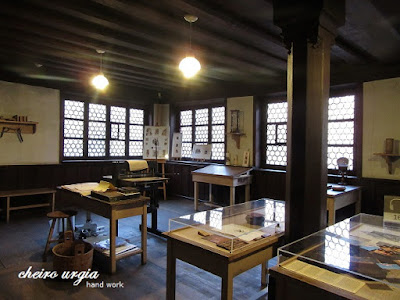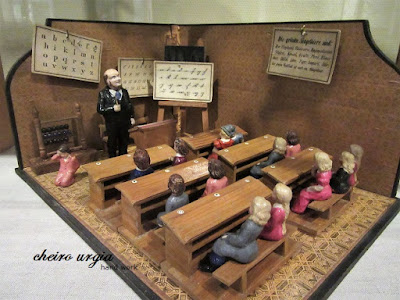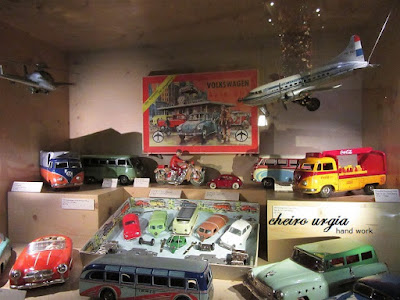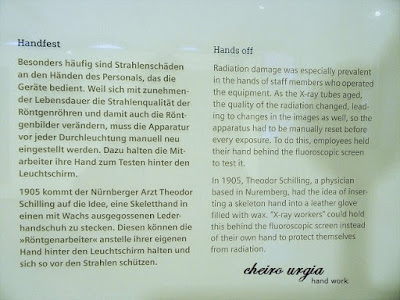Last but not least: For
the second part of my Nürnberg Sunday, I tried to literally catch
some of the museums. Due to the fact they'd soon close, I decided to
go for the Albrecht Dürer house and the Toy museum. Mainly, since
both were on my list of interest from the beginning, but practically,
they are located very close to one another and if I wanted to visit
more than one exhibition that evening, it would probably have to be
this combination.
Why
visit more that one anyway? Because Nürnberg offers a great deal
when it comes to city museums: pay an additional 2.5 € to your
entrance ticket in one of the city museums and you can use it as a
whole-day ticket that enables you to visit as many of the city
museums as you wish (or can) that day. How cool is that?
After leaving the Zoo behind I headed back to the city, pondering up the castle hill through the old center streets for some more fitness and vitamin D points. The houses are neatly renovated and give a feeling of ancient times, while the shop windows stand for Nürnberg's reputation of the "Toy capital" of the world.
And
despite the fact that I've already spotted the Dürer house the
previous day, I ended up looking for it again as the gravity of my
attention focused on the houses underneath the castle walls for some
odd reason. In reality, the master's house is located in the lower
part of the square and would maybe need a couple of banners or
something that would help people to find it right away.
Once
inside, however, the exhibition The Dürer house immediately takes you
to an interesting trip through the past. In the house that was owned
by Nürnberg's most prominent son, you can explore how the life and
work of a recognized painter looked like. Living rooms are placed
next to huge artistic areas, while everything is well explained on
plates as well as on audioguide and interactive elements.
For
the second part of the evening, I headed to the city's Toy museum.
What I thought would be a funny little detour on my way home turned
out to be an interesting journey through thousands of years of play
and playing. Without exaggerating, one might say it shows everything from ancient clay figures to numerous stunningly equipped children's kitchens...
... Dolls in all outfits and sizes one can imagine...
... And lots of boy's stuff, too - even such that was supposed to inspire them to become a priest!Omaha model railway. Built between 1950-1974 by dr. Wolfram Bismarck, one can only imagine how much work and patience went into creating the buildings, trains and 172 m of rails. Unbelievably, Mr. Bismarck never actually visited the original scene, building the functioning railway station based on photographs and descriptions only.
Modest post-WW2 toys...
... And reflections of more recent consumer products.
Special exhibition on music and musical instruments with lots of things that can and will produce noise.
When
I finally left by closing time, it was already dark, meaning I would head
straight to the station to get a good night's sleep before another
week of counting the days till I'd go home.
To
get through another week of whining and self-pity back in Erlangen, I
again used my usual oases of calm.
And
by the end of my stay, I managed to visit another interesting site,
namely the Siemens museum. Its entrance is well visible but might
seem to be disguised as a cafeteria, which hopefully doesn't chase
potential visitors away. In
the free exhibition that is set up in the Siemens building close to
the hospital and offers many interactive materials, one can learn
about the rise of the Siemens family...
... The
development of science in the field of radiation and the introduction of
imaging technologies in medicine...
Who
knew that every medical system is built as a small model first,
followed by a small functioning prototype, and only then by a
functioning model in the original size?
Or
that the 30.000 research & development engineers at Siemens make
about 8.800 inventions a year, or about 40 each day?
Or how big and clumsy the first hearing aids used to be?
Urine samples now and thenOne of the world's smallest ultrasound units, and a good looking one, too. With its weight of only 700 g, it's certainly a wonderful thing to have for any first responder.
And who would dare to imagine medicine without electrification nowadays?
Replica of Germany's first dental drill with an electric engine. Due to its bad isolation however, both patient and doctor were from time to time exposed to electric shocks of 110 V.
Replica of an implantable cardiac pacemaker, 1958. Needless to say its descendants not only look, but also last much longer.
Variations of radiation therapy. Even though in use only a couple of decades ago, they seem pretty medieval in comparison to modern machinery such as the Ion-Beam Therapy Center in Heidelberg. A 670-ton gantry that can be positioned to the millimeter to ensure accurate radiation, while using as much energy as a town with 3000 inhabitants certainly is a stunning gadget.Under the bottom line, the museum sure was one of my Erlangen highlights. Lots to see and lots to learn, and it certainly isn't meant for people with medical background only. Also, apart from the technological achievements, part of the exhibition is dedicated to coping with the unpleasant parts of history.
Nevertheless,
at some point I was just happy to head home.
Because
I expect my commitment to be respected, and the last thing I'd think
of after two weeks of committing my time, energy and knowledge is facing accusations as ridiculous as not having given my real name in first
place.
Because
sometimes the feeling of closing the door is an unbelievably good
one.
And because very soon I'd be heading back to Bavaria for a different kind of German experience.
And because very soon I'd be heading back to Bavaria for a different kind of German experience.
~
the end ~



















































































No comments:
Post a Comment